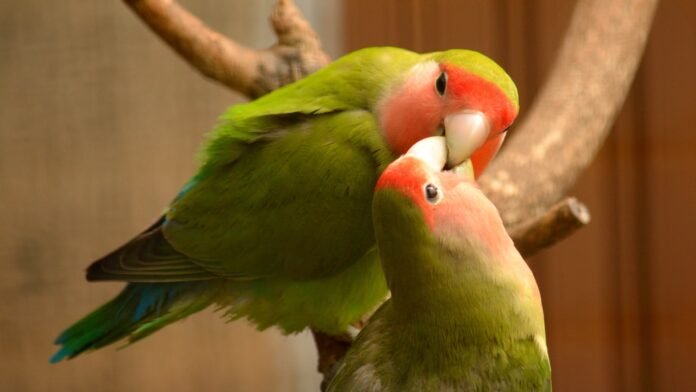Lovebirds are small parrots about five to six inches long and weigh about two ounces. Their heads are round, and their beaks are pretty big.
There are nine different kinds of lovebirds. Their bodies are all green, but their heads and necks are different colours. Some have spots on their heads and necks that are light to bright orange, yellow, grey, black, or red.
Lovebirds come from Africa, including the island of Madagascar, Tanzania, Malawi, Zambia, Botswana, South Africa, Namibia, and Ethiopia, some of the places in Africa where they live.
Lovebirds are popular as pets because they are easy to care for, they like to play, and they have beautiful colours. If they are kept alone, they will try to get attention from their owners. They usually get very close to another lovebird and can stay together for life.
Read More: Feeding Birds
Lovebirds that are kept as pets usually live between 10 and 20 years. In the wild, lovebirds tend to live for only 5 to 10 years. The oldest lovebird that was kept as a pet was 34 years old.
Lovebird Housing
Lovebirds are social birds that live and hunt together in groups. Temperatures between 70 and 80 degrees Fahrenheit are ideal for lovebirds, but they can survive in temperatures ranging from 60 to 90 degrees. They should be kept in a place that doesn’t get direct sunlight and has good airflow but isn’t in direct sunlight.
For a single lovebird, the cage needs to be at least 18″x18″x18″, and for a pair of lovebirds, it needs to be at least 32″x20″x20″. There shouldn’t be more than 3/4 inch between the bars. Make sure there are bowls of food and water, different places to sit, and a place for a water bath.
Lovebirds like to chew on things and look for food on their own. They should be given foraging toys and puzzles to keep them busy and their minds active in captivity. These toys should be switched out every week and bought new every month. Lovebirds should also be able to go outside daily or be given a UV lamp as an alternative ultraviolet light source.
What to Feed a Lovebird
Lovebirds should eat pellets because each bite gives them the necessary nutrients. There are a lot of brands that come in different sizes, colours, and tastes. If a lovebird doesn’t eat pellets, give it a formulated seed mix (seeds stuck together with bullets) to ensure it gets the necessary vitamins and minerals. Between 70 and 80% of their food should be pellets. The other 20–30% can be made of fresh fruits and vegetables. Dried fruits and vegetables don’t have as much nutrition as fresh ones.
Seeds and nuts have a lot of fat, so they should only be eaten occasionally. As a treat, you could serve scrambled or hard-boiled eggs, rice, pasta, whole wheat bread, no-salt crackers, or hard-boiled or soft-boiled potatoes. Treats shouldn’t make up more than 10% of the weekly diet.
Lovebirds should get a new dish of food every day. Any food leftover from the day before should be thrown away. Fresh food should be thrown away within a few hours to keep it from getting dirty or going wrong.
Lovebirds are beautiful, colourful birds that are active and fun to watch. They are good with kids and love to play and hang out with people and other birds. They chirp to talk and are happy to be around people and other birds. The lovebird is curious and lively, making people of all ages smile and laugh.




















